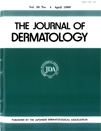Successful Treatment of Adolescent Pemphigus Vulgaris by Immunoadsorption Method
Abstract
A 15-year-old girl with pemphigus vulgaris did not respond to oral administration of prednisolone at 45 mg/day. The skin and oral mucous membrane lesions recurred after effective treatments with methylprednisolone pulse therapy and combination therapy with prednisolone and cyclosporine. The finally successful treatment involved eleven cycles of immunoadsorption using a tryptophan column and administration of a moderate dose of prednisolone. Serum γ-globulin level and anti-intercellular antibody titer decreased from 1.08 g/dl to 0.5 g/dl and 1:320 to 1:20, respectively. She has been well controlled with 21.5 mg/day prednisolone for 8 months after the final adsorption. Considering the physical, mental and social situation of adolescent student patients, immunoadsorption is a highly preferable choice among a variety of treatment modalities for pemphigus vulgaris because it makes the term of hospitalization shorter and avoids undesirable side effects from initial high dose corticosteroids.




